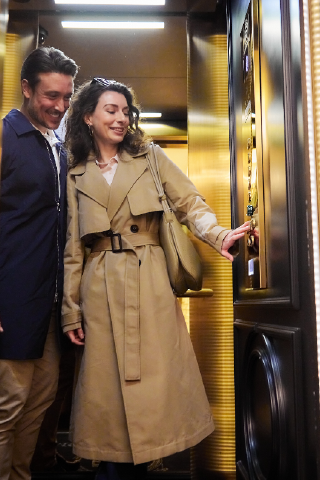KONE Americas Blog
Why KONE’s 24/7 Phone Monitoring Means Smarter, Safer Service
Faster, Safer, and Always Connected
KONE’s Updated DX Elevator Wall Materials
Stylish, Durable Finishes to Elevate Your Building Design
Modernize Escalators Without Replacement | KONE EcoMod™
Upgrade escalator performance without full replacement. KONE EcoMod offers a complete, low-disruption modernization solution for safer, smarter mobility.
The Future of Smart Buildings: A Comprehensive Overview
Discover how AI, IoT, and smart design are revolutionizing how buildings are designed, built, and managed for efficiency, insight, and better user experience.
Help Keep Your Elevators Safe and Reliable: Understanding Equipment Obsolescence
Learn how aging elevator equipment impacts safety, reliability, and costs. Discover proactive upgrade strategies to prevent downtime and ensure compliance with modern standards.
How KONE 24/7 Connected Services Support Retail Elevator and Escalator Performance
Learn how KONE 24/7 Connected Services use predictive maintenance and real-time monitoring to help reduce elevator and escalator downtime in retail spaces.
Smarter Elevators: How KONE 24/7 Connected Services Enhance Office Life
Discover how KONE’s smart elevator solutions and 24/7 Connected Services help optimize building performance, reduce downtime, and improve everyday office life.
Elevator and Escalator Safety Tips for Facility Managers
Prioritizing Passenger Safety Starts with You
Elevator Use During Construction Projects
Elevators are not appliances. They are the only occupied space in your building… that moves.
Why KONE Machine Room-Less Traction Elevators Outperform Hydraulic Systems
Every second counts when moving through a building
Maximizing Space & Design Flexibility
The Advantage of KONE Machine Room-Less Traction Elevators
The Energy Efficiency of Machine Room-Less Elevators
A Smart, Sustainable Choice
Modernizing Elevators During Building Renovation
Why Include Elevator Modernization in Your Renovation?
Elevator Tools for Architects
Seamlessly Integrating Design, Innovation, and Sustainability
Elevator Solutions for Building Owners
Maintenance, Modernization, and Energy Efficiency
Are Escalators Meant to Be Walked On?
The answer is no, and this is why.
The Potential Benefits of Machine Room-Less Elevators for New and Existing Buildings
KONE’s pioneering machine room-less elevators, like the MonoSpace DX and MiniSpace DX, redefine efficiency, sustainability, and user experience in vertical transportation.
Eco-Efficient Elevators
How KONE is Redefining Sustainability in Building Design
How to Choose the Right Elevator for Your Building
A Comprehensive Guide to MRL, Hydraulic, and Other Elevator Technologies
Sustainability in Real Estate: KONE’s Energy-Efficient Elevators Power Green Development
Learn about our work with Hamilton properties to enhance energy efficiency, reduce environmental impact, and support green building initiatives like LEED and PHIUS Zero certification.
Kitten Saved from Elevator Hoistway
A Purr-fect Rescue!
Maximizing Healthcare Elevator Availability
Reliable, dependable elevators are key to smooth people flow – and an optimized patient experience
Elevator Safety and Preparedness in Times of Emergency
In times of emergency, the safety of elevators is often overlooked.
Escalator Etiquette Guide: Safety First, Courtesy Always
Ditch the old "walk left, stand right" rule! Discover the new escalator etiquette guidelines for 2024 and prioritize safety for all.
How Escalators Improve People Flow & Safety in Public Spaces
Discover how escalators revolutionize public spaces by improving people flow, accessibility, and safety. Learn why they're essential for malls, airports, and transit stations.
Elevator Safety During Natural Disasters: Stay Informed and Safe
Be Prepared and Stay Safe: Crucial Guidelines You Need to Know
Why Do Escalators Have Brushes?
Ever wondered about those bristly brushes on escalators? Discover their surprising safety purpose and how they prevent accidents on these moving stairs.
Space Elevator to Geosynchronous Orbit: Science Fiction or Future Reality?
Explore the fascinating concept of a space elevator reaching all the way up to geosynchronous orbit. Is it merely a dream or a feasible future technology?
Elevating Design with KONE: Innovative Online Tools for Elevator and Escalator Planning
KONE's intuitive online tools empower you to design custom elevator interiors, optimize building layouts, and visualize your project with ease.
Machine Room-Less Elevators: Revolutionizing Building Design & Efficiency
Explore the benefits of space-saving, energy-efficient machine room-less (MRL) elevators and discover how MRL technology is transforming modern buildings.
Escalator Safety: Are Escalators Really Safe?
Escalators are often criticized for safety issues, but when used correctly, they're actually among the safest forms of mass transportation available today.
Elevator Safety During Hurricanes and Tropical Storms
Important steps to protect elevators from hurricanes and tropical storms, improving both protection of equipment and passenger safety
What are ADA requirements for elevators?
A simplified breakdown of the ADA requirements for elevators, based on the information from the U.S. Access Board's guide as of 2023
Understanding Elevator Issues: Common Problems and Their Causes
Insights into Elevator Functionality and Failures
What are the safety features of modern escalators and how do they protect users?
Escalators are inherently safer than commonly perceived, and modern advancements in safety features have further enhanced their security, making today's escalators even more reliable.
What are the safety features of modern elevators?
Elevator safety has come a long way, making elevators one of the most safe and convenient mode of transportation for that exist today
How has the elevator industry adapted to meet the needs of people with disabilities?
The elevator industry as a whole is dedicated to inclusivity and safety, ensuring that vertical movement is not a barrier for those with disabilities
The Importance of Regular Elevator Maintenance
How Often Should Elevators be Serviced?
Elevating Experiences: Why the KONE MonoSpace™️ 300 DX Is Revolutionizing Low-Rise Buildings
Maximizing building profitability with sustainable elevator performance, streamlined installation, proven reliability, and it's even customizable!
Elevator and Escalator Safety Tips for Trick-or-Treating in Malls and High-Rise Apartments
Keeping Children Safe During Halloween



















